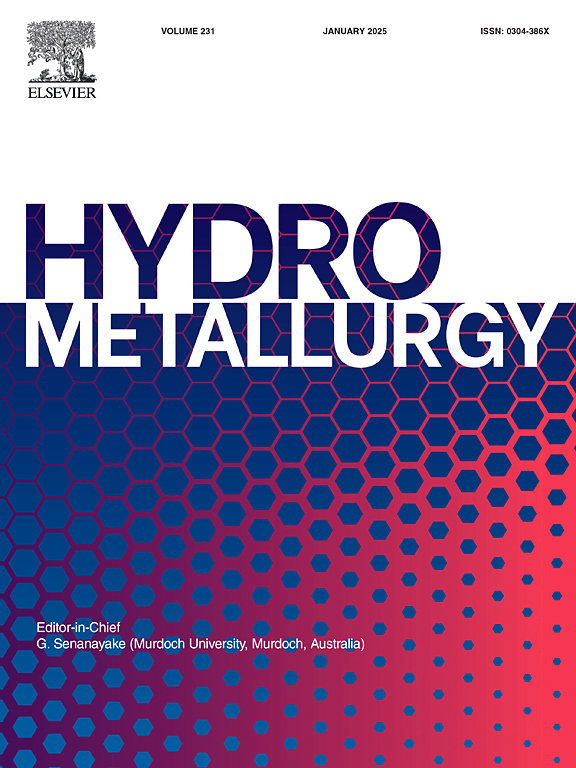Cost effective selective separation of indium and germanium from zinc processing waste leach liquor using D2EHPA-YW100 synergistic system and selective stripping with HCl and NH4F
IF 4.8
2区 材料科学
Q1 METALLURGY & METALLURGICAL ENGINEERING
引用次数: 0
Abstract
Indium and germanium are rare elements and contribute to supporting materials for contemporary high technology new materials. Research and development of efficient separation and extraction of indium and germanium have important practical significance. A new process of “one step extraction and stepwise stripping” is proposed in this work to coextract indium and germanium with D2EHPA-YW100 synergistic system of Di(2-ethylhexyl) phosphoric acid (D2EHPA) and C7–9 hydroxamic acid (YW100) denoted by D2EHPA-YW100. In the coextraction process, 98.9 % of indium and 99.9 % germanium were extracted utilizing an organic phase consisting of YW100 (1.4 %), D2EHPA (15 %) and sulfonated kerosene (83.6 %). During the two-step stripping process, 99.9 % of indium was selectively stripped from the loaded organic phase in step-1 using 4 M HCl. In step-2, 99.5 % of germanium was stripped using a 1 M NH4F solution. This separation resulted the enrichment of germanium concentration by 6–7 fold and indium concentration by 19 fold. This method has four advantages: (i) simplifies the separation process, (ii) reduces equipment investment by nearly 50 %, (iii) minimizes extraction agent loss, and (iv) reduces management and labor costs.
D2EHPA-YW100协同体系与HCl和NH4F选择性汽提对锌加工废液中铟锗进行了经济高效的选择性分离
铟和锗是稀有元素,是当代高科技新材料的支撑材料。研究和开发铟锗的高效分离提取技术具有重要的现实意义。本文提出了以二(2-乙基己基)磷酸(D2EHPA)和C7-9羟肟酸(YW100) (D2EHPA -YW100)为增效体系的D2EHPA-YW100共萃取铟锗的新工艺——“一步萃取-步提”。在共萃取过程中,采用YW100(1.4%)、D2EHPA(15%)和磺化煤油(83.6%)组成的有机相萃取,铟和锗的萃取率分别为98.9%和99.9%。在两步溶出过程中,第一步用4 M HCl选择性地从负载的有机相中溶出99.9%的铟。在步骤2中,使用1 M NH4F溶液剥离99.5%的锗。分离后,锗浓度富集6-7倍,铟浓度富集19倍。该方法有四个优点:(i)简化了分离过程,(ii)减少了近50%的设备投资,(iii)最大限度地减少了萃取剂的损失,(iv)降低了管理和人工成本。
本文章由计算机程序翻译,如有差异,请以英文原文为准。
求助全文
约1分钟内获得全文
求助全文
来源期刊

Hydrometallurgy
工程技术-冶金工程
CiteScore
9.50
自引率
6.40%
发文量
144
审稿时长
3.4 months
期刊介绍:
Hydrometallurgy aims to compile studies on novel processes, process design, chemistry, modelling, control, economics and interfaces between unit operations, and to provide a forum for discussions on case histories and operational difficulties.
Topics covered include: leaching of metal values by chemical reagents or bacterial action at ambient or elevated pressures and temperatures; separation of solids from leach liquors; removal of impurities and recovery of metal values by precipitation, ion exchange, solvent extraction, gaseous reduction, cementation, electro-winning and electro-refining; pre-treatment of ores by roasting or chemical treatments such as halogenation or reduction; recycling of reagents and treatment of effluents.
 求助内容:
求助内容: 应助结果提醒方式:
应助结果提醒方式:


